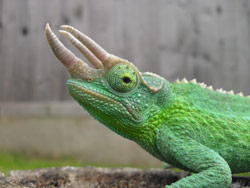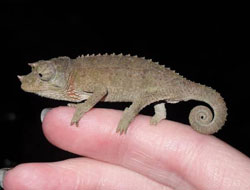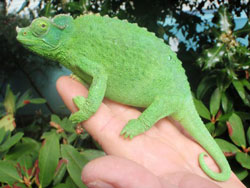Follow along with the video below to see how to install our site as a web app on your home screen.
Note: This feature may not be available in some browsers.
You should upgrade or use an alternative browser.
Jackson's Chameleon

Scientific Name: Trioceros jacksonii xantholophus
Common Names: Jackson's Chameleon
Difficulty: Intermediate - These chameleons are for more experienced keepers. They have additional husbandry requirements that can be difficult for people unfamiliar with general chameleon care.
Brief Introduction:
The Jackson's chameleon is a common reptile in the pet trade due to their unique appearance. This medium sized chameleon is native to the mountainous regions of Kenya and northern Tanzania. There is also a large feral population well established on the Hawaiian Islands after a small group was released in the 1970s. There are three subspecies of Jackson's chameleons: Trioceros jacksonii xantholophus, Trioceros jacksonii jacksonii, and Trioceros jacksonii merumontanus. The latter two species are very rare in captivity and Trioceros jacksonii xantholophus will be the subspecies of focus in this caresheet.
Description:
The Jackson’s chameleon is a medium sized chameleon with an adult length of 10-13” (25-35cm). Though smaller and less colorful than other common species they are easily recognized by the male’s three prominent horns, which give them a prehistoric look. Males and females are predominantly green in color, though females can appear a rusty brown color and may have a darker green irregular pattern when stressed. As a montane species (native to higher altitudes) Jackson’s have more unique heat, humidity and supplementation requirements than more tropical species due to metabolic differences. Interestingly Jackson’s do not lay eggs but instead give birth to live young!
Behavior:
Like most chameleon species Jackson’s chameleons are tree-dwelling reptiles that are active only during the day. They can generally be found hunting prey or basking on the branches of trees and large bushes. Contrary to popular belief, chameleons don’t change color in a direct attempt to match their background. Their color changes are influenced most by their state of health, emotions or level of stress, and the process of thermoregulation. They are territorial and do not tolerate the presence of other chameleons in close proximity, despite the common myth that Jackson's can be housed communally. Like other chameleons they are a pet that is more for observation and should not be handled regularly.
Lifespan:
With proper husbandry Jackson's chameleons can live 3-6 years on average.
Male Jackson's chameleons can be differentiated from females by the three prominent horns on their head. T. xantholophus females do not have horns, or have only one very small horn at the tip of the nose. Click images for larger versions.

Temperature:
Baby/juvenile (<9 months): 70-75F (21-23C) ambient, 75-80F (23-26C) basking
Adult: 70-80F (21-26C) ambient, 82-85F (29C) basking
Ambient temperature refers to the temperature near the bottom of the cage and basking temperature refers to the hottest point accessible to your chameleon. Basking is where a chameleon absorbs heat from an external overhead source to help regulate their body temperature; it also promotes proper digestion and a healthy metabolism. Nighttime temperatures can safely drop down to 50F (10C) so a night heat source should not be used unless temperatures are lower than this. If night heat is needed a ceramic heat emitter or space heater should be used, not a light bulb, even red or black bulbs.
Humidity:
Humidity is an important aspect of chameleon husbandry. Jackson's chameleons require levels around 60-80%, which can be achieved by several misting sessions a day over all areas of the cage. Live plants help increase and maintain humidity. Sometimes a cool mist humidifier or timer-controlled misting system is needed. See Water & Humidity for more information.
Cage Size:
In general when housing chameleons, bigger is better. Jackson’s chameleons are highly territorial and easily stressed by the presence of other chameleons, even of their own species. Two or more Jackson’s chameleons should never be kept in the same cage. Cages should be furnished with many plants and climbing branches to provide opportunities for exercise and plenty of places for hiding. Substrate (mulch, soil, etc.) should not be used in chameleon cages. See Chameleon Enclosures for more information.
screen cage (length x width x height):
16x16x30" (40x40x76cm) - Juveniles
18x18x36" (45x45x90cm) - Adult minimum
Lighting:
All lighting and heat bulbs should be outside and on top of the cage. There should be 12 hours of UVB light, along with 12 hours of darkness for proper rest. A UVB bulb is necessary to synthesize vitamin D3 in the skin and to facilitate absorption of dietary calcium. UVB bulbs only emit UVB rays for 6-8 months, even if they’re still shining, so they must be replaced at least twice a year. A basking bulb creates the heat gradient so that your cold-blooded chameleon can regulate its body temperature by moving into warmer or cooler zones as needed. When choosing a basking bulb start with a 60watt bulb and monitor temperature closely. Higher wattage bulbs are hotter in temperature and vice versa so choose the appropriate wattage bulb based on the temperatures achieved. A bulb that makes it too hot can burn your chameleon badly even from several inches away and through the screen. See Chameleon Lighting for more information.

Feeding:
Chameleons are insectivores meaning they should only be fed live insects. Great feeder insects include crickets, silkworms, hornworms, butterworms, dubia roaches and superworms. Waxworms and mealworms are high in fat content and harder to digest so should only be used on occasion. The rule of thumb is to not feed insects that are longer than the width of your chameleon's head.
Neonates: as many small crickets as they can eat several times a day
Juveniles 3-6 months of age: 10-12 small crickets daily
Juveniles 6-12 months of age: 8-10 medium crickets every other day
Adults over 12 months of age: 6-8 medium-large crickets every other day
Chameleons should be fed in the first half of the day to give them time to bask and digest their food properly. Crickets need to be properly gutloaded with calcium rich vegetables several hours before being fed to your chameleon. Inadequate dietary calcium leads to metabolic bone disease, a very serious illness. Commercially available gutloads usually aren't properly balanced or sufficient for good nutrition. See Chameleon Food for more information.
Supplementation:
Calcium and other vitamins are very important to your chameleon's health. Feeder insects should be lightly dusted with powdered supplement before being fed to your chameleon. As a montane species (native to higher altitudes) Jackson's have decreased supplementation requirements compared to tropical species due to metabolism differences. Use calcium (without D3 or phosphorus) twice a week, a multivitamin once a month, and calcium with D3 once a month.
Hydration & Misting
The cage should be misted at least twice a day, drying out completely between misting sessions. This raises relative humidity as well as stimulates your chameleon to want to drink. Water can be provided by means of a dripper (not a waterfall or water bowl). The dripper should be placed on top of the cage so that the water droplets drip down and accumulate on plant leaves. Other watering options include manual and automated misting sytems. Chameleons do not recognize standing water as a drinking source. See Water & Humidity for more information.

Egg Laying & Breeding
Interestingly Jackson's chameleons do not lay eggs but are viviparous (give birth to live young) after a 6-9 month gestation! Since they do not lay eggs a laying bin does not need to be provided. They can however drop "slugs", which are the membranes and yolk around an egg was never fertilized. A single breeding may produce several clutches from the same pairing due to sperm retention by the female. A few weeks before giving birth the female will usually have decreased appetite or stop eating and become restless. Average clutch size is 7-30 young. The young are born amongst leaves and branches wrapped in a membrane that they need to break open once born. Neonates should be immediately removed from the cage with the mother as predation on the young has been known to occur. The males are born with small nubs where their horns will grow in the future. Babies reach sexual maturity at about 9 months of age.
- Resource Link - Jackson's In Captivity, by Kent Manchen
- Resource Link - Viviparous Birth Photos, by Chris Anderson
- Resource Link - Picture Of A "Slug", by Solid Snake
Nečas, Petr. Chameleons: Nature's Hidden Jewels. Frankfurt Am Main: Edition Chimaira, 1999. Print.




